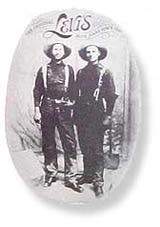Note: This was an article written by Joe Caro that he was generous enough to share with Collectibles readers on About.com. The article has been redirected, so it’s being reproduced here for your reading enjoyment.
– – – –
 Levi Jeans — at one time or another, they were called britches, trousers, overalls, pants and finally jeans. They were guaranteed to shrink, fade and wrinkle and were originally made from brown, canvas sail-cloth intended for use as miners’ tents and Conestroga wagon covers. Invented by a 24-year old German immigrant dry-goods salesman, they are as American as apple pie! We know them fondly today as “501’s”.
Levi Jeans — at one time or another, they were called britches, trousers, overalls, pants and finally jeans. They were guaranteed to shrink, fade and wrinkle and were originally made from brown, canvas sail-cloth intended for use as miners’ tents and Conestroga wagon covers. Invented by a 24-year old German immigrant dry-goods salesman, they are as American as apple pie! We know them fondly today as “501’s”.
When a young Levi Strauss arrived in a bustling, noisy San Francisco in 1853, the rush for California gold riches was still in high gear. The son of a Bavarian dry-good peddler, Levi expected that the mining camps would welcome the buttons, scissors, thread and bolts of fabric that he had brought with him, along with yards of canvas sail cloth that he intended to sell for tent-making and as covers for the the Conestoga wagons that dotted every stream and river.
Opening a little store on California Street with his brother-in-law David Stern, they were immediately successful and their reputation and business grew. It is reported that Levi was often found leading a pack-horse, heavily laden with his merchandise, directly into the mining camps throughout the region. The story goes that both prospectors and miners, often complaining about the easily torn cotton “britches” and pockets that “split right out” gave Levi the idea to make a rugged “overall” trouser for the miners to wear. They were fashioned from bolts of brown canvas sailcloth with gold ore storing pockets that were nearly impossible to split.
Exhausting his original supply of canvas, as the demand grew for his long-wearing overalls, Levi switched to a sturdy fabric called serge, which was made in Nimes, France. Originally called serge de Nimes, this name was soon shortened to “denim”. And, with the development of an indigo dye, the brown color was soon replaced with the now familiar deep blue, the trademark color of most jeans made today.
Another novel trademark, the riveting process, was patented in 1873 and was used to add even more strength to the pocket corners and stress areas of the pants, in addition to another Levi hallmark, using a double stitching or arcuate pattern on the hip pockets, to further increase pocket strength. In 1886, the Two-Horse brand leather patch was first introduced and in 1890, lot numbers were assigned to all products including lot “501”, which contained the first watch pocket.
It is interesting to note that Levi Strauss always disliked the term “jeans” to describe his … well… jeans! The word “jeans” it seems, is derived from the French word genes that was long associated with cotton trousers worn by Italian sailors. It is reported that Levi, and everyone working for him, referred to his denim trousers as waist-high overalls until long after his death in 1902. Not until the mid-1930’s did the company ever refer to them as jeans.
Originally designed as cinch pants to be worn with suspenders, the firm added belt loops in 1922, the red Levi’s tab in 1936 and removed the crotch rivet in 1941. It’s widely rumored that the crotch rivet removal was long overdue and attributed to a troublesome problem suffered by many cowhands while crouching near a roaring campfire on chilly nights out on the range. The story goes that the president of the company, Walter A. Haas, while wearing a new pair of “501’s” experienced first-hand what cowboys had been complaining about for years. Crouched down like that, it seems, the rivet at the base of the fly is mostly exposed to the fire and is an excellent conductor of heat. Shortly after his experience, and by executive order, this single offending rivet was removed forever!
Not a company to change its successful line of clothing without good cause, Levi’s continued to sell its denim overalls with both suspender buttons and belt loops until 1937 when they discontinued the suspender attachments. The next flurry of changes (after the removal of the crotch rivet in 1941) occurred in the ’50’s when the pattern was re-cut for a more tapered leg and pre-shrunk overalls were introduced. 1955 was the year that zippers were introduced to Levi Strauss’s famous overalls with other lots like “Lighter Blues” that marked the company’s entry into the sportswear business. The popularity of the Levi’s jeans grew to such an extent that during World War II the government declared them an essential commodity, and sales were restricted only to defense workers. Demand and price skyrocketed!
With the popularity of the Western movie and stars like John Wayne, Gary Cooper, Gene Autry and Roy Rogers, blue jeans were all the rage. What were originally designed as prospectors working britches now gained the irresistible aura of romance and adventure. The bad-boy, devil-may-care image of Marlon Brando and James Dean in the 1950s established blue jeans as the uniform of the day for the baby boomer generation. In 1960, the company dropped the word overalls from all advertising and finally started calling jeans — “jeans”.
From the California 49’ers to cowboys who were home on the range, to Rosie the Riveter, James Dean and Garth Brooks, the pants that young Levi made, especially lot “501”, have been with us now for well over 100 years. In over 70 countries throughout the world, everyone knows his first name, and continues to eagerly buy millions of of pairs of his pants that are still guaranteed to shrink, wrinkle and fade.

